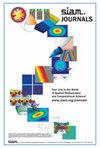Learnable Nonlocal Self-Similarity of Deep Features for Image Denoising
IF 2.1
3区 数学
Q3 COMPUTER SCIENCE, ARTIFICIAL INTELLIGENCE
引用次数: 0
Abstract
SIAM Journal on Imaging Sciences, Volume 17, Issue 1, Page 441-475, March 2024.Abstract. High-dimensional deep features extracted by convolutional neural networks have nonlocal self-similarity. However, incorporating this nonlocal prior of deep features into deep network architectures with an interpretable variational framework is rarely explored. In this paper, we propose a learnable nonlocal self-similarity deep feature network for image denoising. Our method is motivated by the fact that the high-dimensional deep features obey a mixture probability distribution based on the Parzen–Rosenblatt window method. Then a regularizer with learnable nonlocal weights is proposed by considering the dual representation of the log-probability prior of the deep features. Specifically, the nonlocal weights are introduced as dual variables that can be learned by unrolling the associated numerical scheme. This leads to nonlocal modules (NLMs) in newly designed networks. Our method provides a statistical and variational interpretation for the nonlocal self-attention mechanism widely used in various networks. By adopting nonoverlapping window and region decomposition techniques, we can significantly reduce the computational complexity of nonlocal self-similarity, thus enabling parallel computation of the NLM. The solution to the proposed variational problem can be formulated as a learnable nonlocal self-similarity network for image denoising. This work offers a novel approach for constructing network structures that consider self-similarity and nonlocality. The improvements achieved by this method are predictable and partially controllable. Compared with several closely related denoising methods, the experimental results show the effectiveness of the proposed method in image denoising.
用于图像去噪的深度特征的可学习非局部自相似性
SIAM 影像科学杂志》第 17 卷第 1 期第 441-475 页,2024 年 3 月。 摘要卷积神经网络提取的高维深度特征具有非局部自相似性。然而,将深度特征的这种非局部先验性纳入具有可解释变异框架的深度网络体系结构的研究却很少。在本文中,我们提出了一种用于图像去噪的可学习非局部自相似性深度特征网络。我们的方法基于 Parzen-Rosenblatt 窗口法,其高维深度特征服从混合概率分布。然后,通过考虑深度特征的对数概率先验的对偶表示,提出了一种具有可学习非局部权重的正则化器。具体来说,非局部权重是作为对偶变量引入的,可以通过展开相关的数值方案来学习。这就导致了新设计网络中的非局部模块(NLM)。我们的方法为广泛应用于各种网络的非局部自注意机制提供了统计和变异解释。通过采用非重叠窗口和区域分解技术,我们可以显著降低非局部自相似性的计算复杂度,从而实现 NLM 的并行计算。所提出的变分问题的解决方案可以表述为用于图像去噪的可学习非局部自相似性网络。这项工作为构建考虑自相似性和非局部性的网络结构提供了一种新方法。这种方法实现的改进是可预测和部分可控的。与几种密切相关的去噪方法相比,实验结果表明了所提方法在图像去噪方面的有效性。
本文章由计算机程序翻译,如有差异,请以英文原文为准。
求助全文
约1分钟内获得全文
求助全文
来源期刊

SIAM Journal on Imaging Sciences
COMPUTER SCIENCE, ARTIFICIAL INTELLIGENCE-COMPUTER SCIENCE, SOFTWARE ENGINEERING
CiteScore
3.80
自引率
4.80%
发文量
58
审稿时长
>12 weeks
期刊介绍:
SIAM Journal on Imaging Sciences (SIIMS) covers all areas of imaging sciences, broadly interpreted. It includes image formation, image processing, image analysis, image interpretation and understanding, imaging-related machine learning, and inverse problems in imaging; leading to applications to diverse areas in science, medicine, engineering, and other fields. The journal’s scope is meant to be broad enough to include areas now organized under the terms image processing, image analysis, computer graphics, computer vision, visual machine learning, and visualization. Formal approaches, at the level of mathematics and/or computations, as well as state-of-the-art practical results, are expected from manuscripts published in SIIMS. SIIMS is mathematically and computationally based, and offers a unique forum to highlight the commonality of methodology, models, and algorithms among diverse application areas of imaging sciences. SIIMS provides a broad authoritative source for fundamental results in imaging sciences, with a unique combination of mathematics and applications.
SIIMS covers a broad range of areas, including but not limited to image formation, image processing, image analysis, computer graphics, computer vision, visualization, image understanding, pattern analysis, machine intelligence, remote sensing, geoscience, signal processing, medical and biomedical imaging, and seismic imaging. The fundamental mathematical theories addressing imaging problems covered by SIIMS include, but are not limited to, harmonic analysis, partial differential equations, differential geometry, numerical analysis, information theory, learning, optimization, statistics, and probability. Research papers that innovate both in the fundamentals and in the applications are especially welcome. SIIMS focuses on conceptually new ideas, methods, and fundamentals as applied to all aspects of imaging sciences.
 求助内容:
求助内容: 应助结果提醒方式:
应助结果提醒方式:


